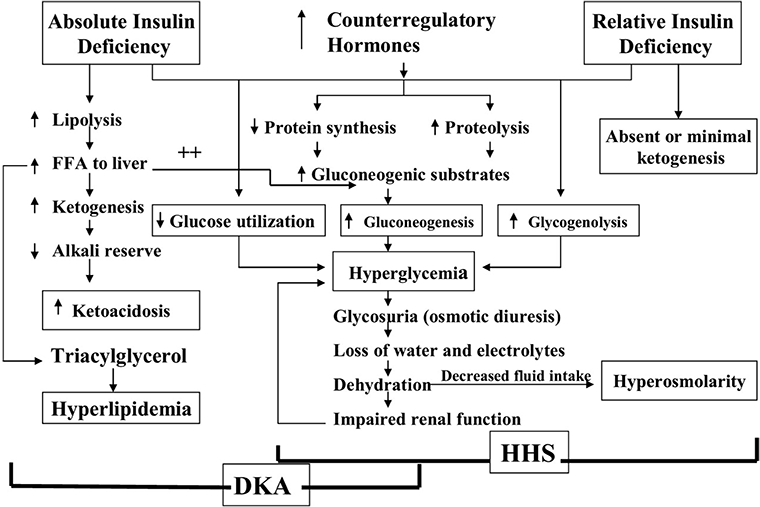Aetiology
In DKA, there is a reduction in the net effective concentration of circulating insulin along with an elevation of counter-regulatory hormones (glucagon, catecholamines, cortisol, and growth hormone). These alterations lead to the extreme manifestations of metabolic derangements that can occur in diabetes. The two most common precipitating events are infection and discontinuation of, or inadequate, insulin therapy. Underlying medical conditions, such as myocardial infarction or pancreatitis, that provoke the release of counter-regulatory hormones are also likely to result in DKA in patients with diabetes.[15] Drugs that affect carbohydrate metabolism, such as corticosteroids, thiazides, sympathomimetic agents (e.g., dobutamine and terbutaline), second-generation antipsychotics, immune checkpoint inhibitors, cocaine, and cannabis may contribute to the development of DKA.[1][16][17] The use of sodium-glucose co-transporter 2 (SGLT2) inhibitors has also been implicated in the development of DKA in patients with both type 1 and type 2 diabetes.[18][19][20][21][22]
Pathophysiology
Reduced insulin concentration or action, along with increased insulin counter-regulatory hormones, leads to the hyperglycaemia, volume depletion, and electrolyte imbalance that underlie the pathophysiology of DKA. Hormonal alterations lead to increased gluconeogenesis, hepatic and renal glucose production, and impaired glucose utilisation in peripheral tissues, which results in hyperglycaemia and hyperosmolarity. Insulin deficiency leads to release of free fatty acids from adipose tissue (lipolysis), hepatic fatty acid oxidation, and formation of ketone bodies (beta-hydroxybutyrate and acetoacetate), which result in ketonaemia and acidosis. Studies have demonstrated the elevation of pro-inflammatory cytokines and inflammatory biomarkers (e.g., C-reactive protein [CRP]), markers of oxidative stress, lipid peroxidation, and cardiovascular risk factors with hyperglycaemic crises. All of these parameters return to normal following insulin and hydration therapies within 24 hours of hyperglycaemic crises. Elevation of pro-inflammatory cytokines, and markers of lipid peroxidation and oxidative stress, have also been demonstrated in people without diabetes with insulin-induced hypoglycaemia.[23] The observed pro-inflammatory and pro-coagulant states in hyperglycaemic crises and hypoglycaemia may be the result of adaptive responses to acute stress, and not hyperglycaemia or hypoglycaemia per se.[1][23][24] It has also been postulated that ketosis-prone diabetes comprises different syndromes based on auto-antibody status, HLA genotype, and beta-cell functional reserve.[25]
[Figure caption and citation for the preceding image starts]: Pathogenesis of DKA and HHS; triggers include stress, infection, and insufficient insulin. FFA: free fatty acid; HHS: hyperosmolar hyperglycaemic stateFrom: Kitabchi AE, Umpierrez GE, Miles JM, et al. Diabetes Care. 2009,32:1335-43; used with permission [Citation ends].
Classification
Severe DKA
The presence of one or more of the following may indicate severe DKA:[4]
Blood ketones >6 mmol/L
Bicarbonate <5 mmol/L
Venous/arterial pH <7.0
Hypokalaemia on admission (<3.5 mmol/L)
Glasgow Coma Scale <12 [ Glasgow Coma Scale Opens in new window ]
Oxygen saturation <92% on air (assuming normal baseline respiratory function)
Systolic blood pressure (SBP) <90 mmHg
Pulse >100 bpm or <60 bpm
Anion gap >16 [ Anion Gap Opens in new window ]
Use of this content is subject to our disclaimer

